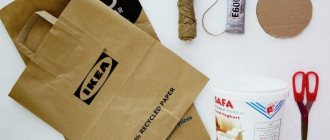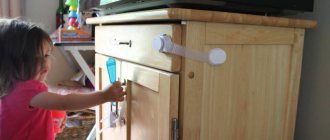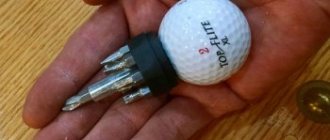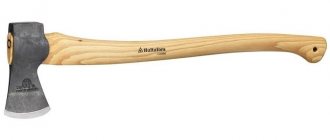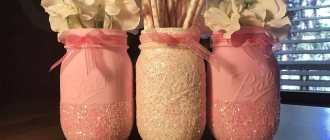Photo: dekormyhome.ru Even the most beloved cabinets get scuffed, scratched or faded over time. The paint peels off, the wood dries, and the varnish becomes cloudy. But what if we turn this from a disadvantage into a feature? You won't have to sadly say goodbye to your favorite furniture and spend money on new ones! And we are ready to help with interesting ideas and inspiration for new achievements!
Brushing
The easiest way to update an old cabinet is, oddly enough, by aging it. This type of furniture is especially good in luxurious classic interiors, Provence, loft and any other styles that tend to be retro.
To make scuffs look natural, choose the right places for them. Furniture gets worn down most quickly where it bears a load or is constantly touched: edges, corners, handles, tabletops, protruding relief.
Mechanical abrasions are created using brushing technology: the surface is treated with a hard metal brush, which removes paint and soft fibers. The technology is good for cabinets made of larch, pine, ash or oak.
Photo: hammer-shop.ru Photo: stamwood.ru
How to restore?
Any antique cabinet requires a little restoration, which will significantly improve its appearance.
You can restore the wardrobe yourself if you use the advice of experts:
- A metal brush is used to treat decayed wood, after which the dead tissue is removed.
- The fine dust formed in this case is washed off under running water.
- Sometimes there are holes from nails, some unevenness and cracks in the wooden elements of the cabinet. All this must be cleaned with a spatula. It is necessary to apply several thin layers of putty to match the wood. Each layer must dry before applying the next.
- Then dry all layers in fresh air for 1-2 days. Do not dry wood in the sun.
- Sometimes there are metal parts in furniture that have become covered with rust over time; such places should be treated with a special solution.
- The restored surface can then be painted or decorated at your discretion.
- A self-adhesive film that imitates wood, stone, or metal is perfect.
Craquelure
Craquelure is the creation of a fine mesh of cracks on a surface using paint and a special varnish. It comes in two types: one-step - when the base or bottom layer directly peeks out from under the cracks of the paint; two-step - when under the craquelure there is another decorative coating or image.
In the simplest technology, the surface of the cabinet is first coated with a dark pigment, followed by colored or contrasting paint. And after drying, a craquelure varnish is applied, which provokes cracking. This option is suitable not only for wood, but also for cabinets made of any other materials.
Photo: berkem.ru
Photo: severdv.ru
How to paint?
A cabinet that has gone out of fashion, but is still quite strong and will last for many years, can simply be repainted. In this simple way, a new design of cabinets, chests of drawers and any other old furniture is created. In this case, we are talking not only about giving freshness to dull surfaces, but also about completely replacing the color scheme, which will add originality to the product. Painting is the most common option for updating an old item. Despite its simplicity, it is necessary to approach this process correctly. For a long-lasting result, you must first prepare the furniture walls.
Below is a step-by-step master class.
It will help you to carry out high-quality and competent painting at home:
- it is important to first clean the surfaces of paint residues: one layer will easily remove the sanding disc; special brushes can handle several layers as an attachment;
- all walls, doors and other parts must be sanded manually or using a tool;
- leveling occurs by applying a primer or putty to hide defects that have arisen during many years of use;
- you need to wait until the leveling layer has completely dried, and after that you can start painting;
- To apply a layer of paint on all sides, take a brush, roller or sponge; however, it is faster to use a spray gun or spray gun. With this method, the paint is applied under pressure, so the doors, shelves and walls inside the cabinet are well painted;
- As a rule, several layers of paint are applied. This ensures rich color and good surface preservation. It is better to paint the cabinet with acrylic, alkyd enamel or other high-quality paint;
- the paint must be allowed to dry completely, after which a layer of varnish can be applied. It makes the cabinet look glossy and shiny. If you prefer a matte surface, you can skip varnishing. However, the use of this coating has a protective function, prevents abrasion and gives the tone greater depth. You can use not only glossy, but also matte and silky finishes.
Elegant abrasions
If brushing is too rough for your taste, there are more elegant aging techniques. Pay attention to this one if your interior is designed in Provence, boho or shabby chic style.
First, colored paint of a rich or pastel shade is applied to the surface - but always noticeable. After drying, it is thickly rubbed with paraffin or wax, and then a second layer of light paint is applied.
The wax is removed with regular sandpaper, and the bottom layer appears under the light coating. Delicate aging looks especially good in milky, beige, cream, olive, lavender, linen, pistachio and soft pink bases.
Photo: severdv.ru
Photo: pinterest.ru
Make a base
1. Process the material for the manufacture of the front and side boards of the base O, P . Saw off the front board to the specified length, and leave an allowance of about 25 mm on the side boards.
of 25 mm into the collet of the router fixed in the table, make roundings on both ends of the front board O and one end of each of the side boards R. Then mark and file the bevels on all three pieces (Photo I).
Mill the roundings at the ends of the base boards O, P, then mark and make bevels. The side boards will be sawn to final length later.
Place the front base board O on the bottom panel at a distance of 16 mm from the edge, aligned to the center, and glue, securing with clamps.
3. Mark the cutout on the front board O in accordance with the template (Fig. 2) and cut it out, leaving a small allowance. Sand the edges smooth and make 3mm fillets on the bottom edges of the legs and the bottom edges of the side boards P. Finish the base parts with 220 sandpaper.
4. Place the bottom panel L/M/N on the stands, upside down (photo J ). Glue the front base board O to the underside of the panel (Fig. 2c).
5. When the glue has dried, attach the side boards of the base P board O and place marks on them flush with the ends of the side plates N. Saw the side boards to the final length, glue them in place and secure with clamps.
6. Cut out the rear gussets Q and the front bosses R of the specified sizes and shapes. Make 10mm chamfers on the front bosses for installation of clamps. When the glued base has dried, glue the gussets and bosses into place, securing them with clamps (Fig. 2).
splashing
You can radically transform old furniture with ordinary decorative painting. Moreover, you don’t have to be able to draw to do this, because now abstraction, geometry and simplicity are in fashion.
A bright and creative accent in a modern interior will be an artistically splattered cabinet, as if it had just come from a painter’s studio. You will only need brushes, paints, water and newspaper or oilcloth to cover your work area.
Choose the spraying technology that you like best: just shake the brush onto the surface, paint with a toothbrush or toothpick, knock small drops from a wide brush. Until the paint dries, the result can always be corrected, especially since negligence here is a trick, not a mistake. Finally, varnish the cabinet to preserve your efforts.
Photo: proffstroygroup.ru
DIY old table decor: 14 easy ideas
Popular painting options
The most common option is simple decorative painting of furniture. Basically this is the application of small elements, ornaments or repeating patterns. For a simple drawing, paint of one color is used, and to simplify the process, templates or stencils are used for painting. This type of decoration is suitable for modern furniture. Gilding is widespread. This type of painting is typical for interiors in classical styles. Curly elements of furniture decoration are decorated with gold.
A more complex option is artistic painting. This is quite a painstaking work; all stages of the bark are performed manually, including the smallest details. Painting on furniture can be in the form of a pattern or a small fragment, or it can also be a complex three-dimensional design. Author's works are especially valued.
A special place is occupied by the production of antique interior items. This also includes the restoration of old furniture. Various painting techniques and styles are used in the work. Surfaces and finishing elements are subjected to “aging” in various ways. Antiques are very popular among wealthy people and collectors. Usually this type of decoration is made to order.
Glaze
Glazing is another artistic technique, which boils down to the fact that the bottom layer of paint is visible through the translucent top one. The result is complex iridescent shades that play interestingly in the light.
The advantage of technology is that you can use almost any paint: oil, acrylic, watercolor, even strong tea. Dilute the acrylic with water to the desired shade and consistency and apply it with a sponge or synthetic brush. Glazing does not imply a dense, uniform coating; in fact, it is just tinting.
Photo: id.pinterest.com
Photo: mebel-mart32.ru
Video description
The video shows how to apply large posters to wardrobe doors:
Method three - stained glass
It is easy to remove the doors and replace them with stained glass windows made in specialized workshops. Only wealthy people can do this. But even here, if you wish, it is not difficult to save money by choosing translucent stained glass film instead of stained glass finishing. It is also allowed to be used if the doors have a mirror surface.
Bright stained glass film for a closet in the living room Source maksdecor.ru
The film has a translucent base. It lets light through. It is reflected from the mirror and comes back. In this way, a glow effect is formed, similar to the reflection of colored glass. The film is applied in the same way as a vinyl sticker. The following photo allows you to evaluate the result.
Bright stained glass films Source i.ytimg.com
Staining
Stain is a tinting liquid that allows you to change the shade of wood, but completely preserve its texture. Apply it strictly parallel to the fibers, and paint over it with several layers of varnish or pearlescent glaze coating.
Soft fibers absorb the coloring composition more strongly, and from dense fibers it is washed off naturally. If you want to make the texture even more expressive, repeat the process several times. In order not to miss the result, first try the stain on that part of the cabinet where it is not visible.
Photo: kuzmich24.ru Photo: rusremeslo.ru
First make the sides
1. Cut out the side panels A according to the dimensions specified in the “List of Materials”. Unravel the thickness of the workpiece measuring 51×711 mm and sharpen it to form two workpieces 6 mm thick. B of the specified length from these blanks (Fig. 1).
Quick tip! To avoid staining the front sides of the panels, use a saw to make shallow catch cuts on the back of the trims to catch excess glue.
Glue the trim to the panels flush with the top and bottom edges.
2. For the front and rear pillars C, D, choose straight-layer boards 38 mm thick or glue blanks from several layers. From this material, cut two blanks measuring 32x70x775 mm. Position the longitudinal (parallel) fence of the saw machine at a distance of 12 mm from the blade, raise the blade to a height of 12 mm and make a cut on one face of each workpiece and trim at least 19 mm thick. Move the rip fence slightly away from the blade and make another pass to widen the cut on the trim. Check how the plywood from which the rear panels will be made is inserted into it . If necessary, readjust the rip fence and make another cut to achieve a tight fit. Then widen the tongues on both pieces.
3. Having installed the router in the table, attach a shaped cutter for roundings with a radius of 25 mm into the collet and, gradually increasing its reach, in several passes mill a rounding on each workpiece on the edge opposite to the cut (Fig. 1a). Then install a 6mm diameter straight slot cutter and attach a scrap stopper to the rip fence at a distance of 45mm from the cutter (Photo A). Move the longitudinal stop to a distance of 12 mm from the cutter and mill a partial tongue in one of the blanks from which the left front and rear pillars C, D .
Attach the scrap stopper to the longitudinal stop of the milling table on the left at a distance of 45 mm from the cutter. With these settings, make a partial tongue in only one piece.
Reposition the stopper and lower the second workpiece onto the rotating cutter. After taking out an incomplete tongue, this workpiece will be a mirror copy of the first one.
Pressure bars cut from scraps will help to press the front pillars C with clamps. The inner sides of the pillars C, D and panel A should be aligned in the same plane.
4. To make the same partial tongue on the workpiece for the front and rear posts of the right wall, place the stopper on the opposite side of the cutter (photo B). Pressing the second piece firmly against the rip fence and stopper, lower it onto the rotating cutter and slide it along the stop to remove the incomplete tongue. Using a chisel, carefully trim the corners at the end of the tongue in both pieces.
5. Saw both pieces lengthwise to create two front C and two rear D posts 32mm wide. Mill 2mm fillets on the outer edges of the posts (Fig. 1b) . Sand the pieces with 220-grit sandpaper and glue the posts to the side panels A (Photo C).
Decoupage
Simple and affordable technology with a minimum number of tools and consumables has won the love of decorators around the world. In fact, this is almost an applique, for which paper napkins with drawings or special blanks are suitable.
Thoroughly clean and level the base so that the surface is completely smooth. If you are decorating a metal or glass shelf, wash and degrease it.
If necessary, you can first paint the cabinet with acrylic paint, but then wait until it is completely dry. Then apply a weak solution of PVA with water to the surface and place a top layer of patterned napkins on it. The whole thing is covered again with diluted PVA, and after drying, with a transparent varnish for smoothness and durability.
Photo: severdv.ru Photo: avito.ru
Restoration in Art Deco style
Art Deco gained its greatest popularity at the end of the twentieth century. The characteristic features of this design are luxury, shine, and high cost of finishing materials. The colors of the interior and furniture are predominantly white, black, and gold. Accenting with purple, red, green and brown colors is allowed. Black and white portraits of famous people of the past would be appropriate here. This style is inherent in the gangster layers.
Stylish dark purple wardrobe with golden elements
In DIY furniture design, this direction can be expressed in different ways. Regarding cabinets and chests of drawers, these can be either plain facades and panels painted with acrylic paint in one or two colors, or decorated furniture using decoupage.
Decoupage napkins or film are a universal and practical way to give the interior and furniture a creative look. Its shapes, patterns, colors, prints are widely represented in paint stores. In Art Deco, these could be the same faces of the bandits of the past, or, as has become very fashionable, the figure of the unforgettable Marilyn Monroe.
First, the entire cabinet is painted in primary colors. To make the borders clear, use masking tape.
Then the panels are decorated using decoupage technique
The final stage is applying a protective layer of varnish
It would be interesting to use a special varnish that has crackle properties when covering decoupaged furniture facades.
Patination
Patina is a characteristic antique coating that occurs when bronze or copper oxidizes. Its natural color is greenish-brown, but other options are used in decoration, including colored ones.
Apply bitumen varnish to the base and immediately wipe the surface so that it remains only in relief and recesses. And on top, coat the cabinet with a special shellac varnish, which at the same time provides resistance to scratches and damage.
Shellac varnish itself gives the surface a tone of old copper or gold. At the same time, it emphasizes the wood texture well, so it is often used to patina wooden furniture on its own.
Photo: mebel-v-nsk.ru
Acrylic patina is ordinary diluted acrylic paint of a suitable shade. It is spilled in the same way on the raised areas, and all excess is wiped off with a clean rag.
Wax patina is a separate composition that is rubbed over the surface, giving it a tint and a characteristic satin sheen.
Chemical patina looks the most natural, because it simply speeds up natural processes hundreds of times. Paint the cabinet with paint containing fine metal particles and apply a special oxidizing agent on top.
Photo: trikita-spb.ru
10 cool ideas on how to decorate your apartment for the New Year
Etching
Etching is a more complex chemical process than staining, so it requires careful preparation and selection of reagents. But this technology is good for cabinets made of hardwood. This way you can give them a rich, deep shade and emphasize the texture.
The simplest home recipes use decoctions of leaves, bark, tea, coffee, and potassium permanganate. But more effective are chemical components that can be purchased immediately with instructions for application and indicating the exposure time for different types of wood.
Photo: forum.guns.ru
For example, 1% copper sulfate will help give oak a brown tint, 1% iron sulfate will give it a gray-lilac tint, and 4-5% iron will help give it a blue-black hue. You can paint a birch dark red with zinc sulfate, and greenish-yellow with potassium chromium.
Calcium chloride gives the coffee shade to light rocks, and Epsom salt gives the unusual purple color. And different combinations of these reagents create olive, lilac and golden tones.
Photo: pinterest.ru
Dry brush
Dry brushing is another technique that decorators learned from painters for elegantly distressing old cabinets for classic interiors. Take a little paint onto a flat synthetic brush, wipe off the excess on a rag or paper, and then brush over the base.
Do not press too hard, but go lightly around corners, joints and protruding parts. The brush hairs do not leave continuous lines, and the result is not a dense coating, but as if scratched.
Photo: kraski-net.ru
Photo: proffstroygroup.ru
Epoxy resin
Epoxy resin hardens quickly in open air and creates a beautiful translucent coating. By itself, it gives a golden or amber tint or creates the effect of glass or ice.
Deep cracks or noticeable defects on the surface of the cabinet can be filled with colored sand, small shells or any other decorations - and filled with resin on top. And small cracks will literally come to life if you add luminescent powder to the epoxy.
Photo: vk.com
Photo: usamodelkina.ru
Self-adhesive film
If you don’t want to bother with paint, varnish and resin, there is an even simpler solution - decorative film. The stores offer many collections, from imitations of other materials to photo printing, textured, luminous and mirror coatings.
First, mark the film and cut it, and then glue it like tape, slowly and carefully pressing it to the base and expelling the bubbles. The main nuance is to carefully level the surface of the cabinet in advance, otherwise the film will highlight all the defects.
Photo: br.pinterest.com
10 best ideas on how to decorate a room for the New Year
Review of beautiful cabinets, tips for choosing
Wardrobes are one of the most essential pieces of furniture in a home. Everyone strives to equip their home not only as rationally as possible, but also to choose furniture that will look as impressive as possible, without cluttering up the free space of the room. The developers offer a wide selection; anyone can purchase beautiful cabinets for their home. The variety of materials from which furniture is made is enormous, and the creativity of designers in the design of facades truly knows no bounds. Cabinets are produced in different shapes and sizes, using high-quality, environmentally friendly materials; the walls and doors are decorated with patterns, colors, glass and mirror inserts.
Stencils
If you still want to paint a closet, but lack the skills, use stencils. You can print and cut them yourself or purchase them ready-made at an art store.
Surface preparation is the same as for any other painting: stripping, sanding, base coat. Apply light markings on top with a pencil so that the drawing does not move while working. Secure the stencil to the surface with masking tape to prevent it from fidgeting - and start painting.
If you want, take paint in a can, but then take care of additional surface protection. Instead of stencils, you can use old tulle, unnecessary openwork fabric and any other suitable materials.
Photo: pinterest.ru
Photo: dekormyhome.ru
Shelves at the end of the closet and more
If the wardrobe is designed for clothes on hangers, then its depth is quite large, about 600-700mm. If this space is located facing the hallway entrance, it is better to use it for an “extension”. For example, in the form of additional corner shelves of various shapes.
Shelves at the end of the closet can also become a full-fledged open hallway, designed as a continuation of a row of furniture with hangers, a cabinet for shoes, etc.
So they should be quite compact, designed for storing small-sized items.
Upholstery
An interesting and unusual decoration for an old cabinet is upholstery with a different material. But this should be the most ordinary cabinet of a simple shape and without relief decoration. Instead of stained fabric that cannot be removed, use dermantin, leatherette and their variations for upholstery.
Regular glue is suitable for attaching the canvas - the main thing is that there are no bruises or air bubbles. Decorate the edges, corners, ends and other areas with decorative nails and rivets. This type of finishing will take a lot of time, but it will fit luxuriously into English interiors or lofts.
Photo: arivamebel-ekb.ru
Wallpaper can also be glued to furniture
It is better to use vinyl wallpaper and special glue. Having previously carried out an inspection and restoration, we do the following.
- During restoration, leave unpainted areas on which you will paste wallpaper.
Treat them with acetone or gasoline. Apply primer. - Make accurate drawings of the areas on the wallpaper and cut them out.
- Carefully coat the cut piece of wallpaper with glue and carefully apply it to the surface.
- Smooth with a special roller or dry, clean cloth.
Avoid peeling and blistering.
ON A NOTE! If there are no convex or decorative elements on the outer surface of the old cabinet, then you can completely cover it with wallpaper.
DIY old cabinet decor - photo ideas
These are not all the options that you can easily implement with your own hands. After all, an old cabinet has nothing left to lose, so don't limit your imagination. And we offer a few more ideas for this!
Photo: modadekorum.com Photo: design-homes.ru Photo: pinterest.at
Photo: severdv.ru
Photo: vseme.ru
Photo: dekormyhome.ru Photo: asusfone.ru
Photo: severdv.ru
Photo: severdv.ru
Photo: azbukaplavania.ru
Photo: remont-samomy.ru
Photo: asusfone.ru
Photo: id.pinterest.com Photo: tr.pinterest.com Photo: uutvdome.ru
Photo: sharesunday.com Photo: fi.pinterest.com
Photo: market.yandex.ru
Surface decoration
There are many DIY ways to update your cabinets. The most popular, even today, is painting cabinet furniture. The decor of a sliding wardrobe or a standard version simply cannot do without painting, and bright colors will help the old product sparkle with new colors. In order for the paint to last a long time and look beautiful, you need to follow the rules:
- Preferably use acrylic paints;
- sand the surface well;
- eliminate in advance any imperfections that become visible after painting.
